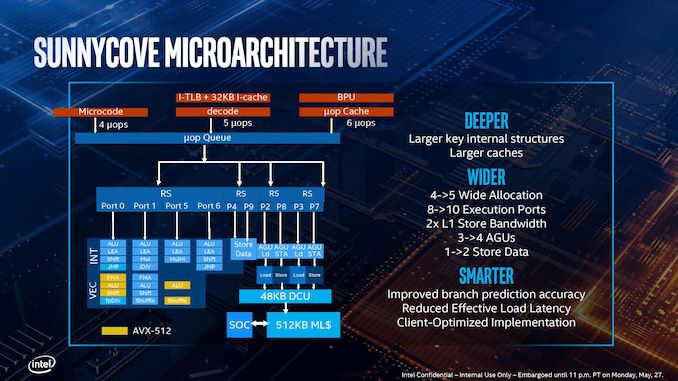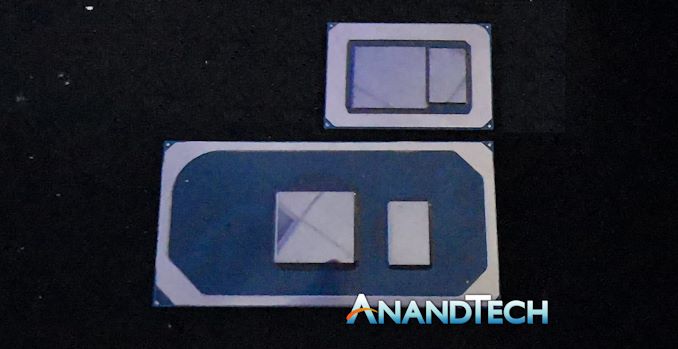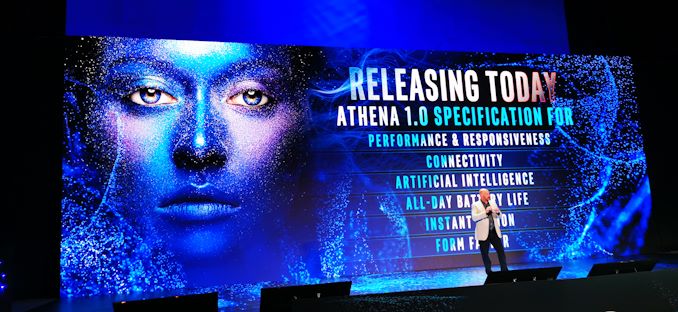Examining Intel's Ice Lake Processors: Taking a Bite of the Sunny Cove Microarchitecture
by Dr. Ian Cutress on July 30, 2019 9:30 AM EST- Posted in
- CPUs
- Intel
- 10nm
- Microarchitecture
- Ice Lake
- Project Athena
- Sunny Cove
- Gen11
Intel’s Ice Lake and Sunny Cove
A Welcome Update, with Questions on Execution
When launching a new mobile product using a new processor design, all the parts have to come together to make it work. This means all of the following:
- The microarchitecture design
- SoC implementation
- Manufacturing
- Co-operation with partners/OEMs
- Time to Market
- Messaging
- Marketing
- Interactions with the press and consumers
- Promotion
- Price
- Competitiveness
Any one of these segments could make or break the next wave of innovation (a key phrase Intel likes to use). With Intel’s 10nm manufacturing process, and the 10th Gen Core 'Ice Lake' design, we’re moving along each of these points in turn, and it is interesting to see what the final reflection will be several years down the line. From our perspective, we now have extensive details on the core and the SoC, and Intel is slowly moving into product phase by the end of the year. We can evaluate what we’ve seen.
The Core and the SoC
Having ‘not another Skylake’ is a huge sigh of relief. With every new microarchitecture update, especially significant ones, we like to see how the power budget is being used and what key structures within the microarchitecture have been improved and expanded upon. The team behind the Sunny Cove core have listed some impressive hard numbers, with doubling the L1 store bandwidth, making significant L1 and L2 cache adjustments, increasing the reorder buffer a whopping +57%, and moving to a 10-port execution unit design. The inclusion of AVX-512 is welcomed by parts of the community for sure, although I expect not as many as Intel would like (this leads onto Intel’s DLBoost strategy, I’ll mention later). Assuming we can get the same +18% IPC metrics that Intel does, this is a great uplift and it will be exciting to see where we go from here.
On the SoC, the big improvements to the graphics and the memory controller are my important ones here. Intel is taking integrated graphics seriously again, with an improved 64 EU design that promises to match AMD’s best at 25W. Intel has improved its memory controller significantly here, now supporting LPDDR4-3733 and DDR4-3200, which helps given that the graphics hardware is always craving memory bandwidth.
Adding Thunderbolt 3 to the SoC is going to help drive adoption in the mobile space, however speaking to a number of press, we think that because TB3 still requires an expensive controller on the device end, that the standard still has that high-cost to entry barrier, even if it ends up being cheaper for host implementation. Until non-Intel TB3 device controllers hit the market, the biggest benefit here is going to be potential support for the USB4 standard. With respect to the Wi-Fi 6 enablement, I’m not so enthused here, as it still requires an additional Intel-only proprietary CNVi module, forcing OEMs to go down an Intel route. If Intel made the CNVi standard open to all, I’d be making a bigger deal about this.
Manufacturing and Time To Market
The fact that Intel is going to end up competing against itself, with Ice Lake-U against Comet Lake-U, is akin to shooting yourself in the foot. Ultimately we expect Ice Lake-U to be focused on the premium market through Intel’s Project Athena, but Comet Lake-U is likely to span from budget to premium as well, especially if it ends up supporting more cores than Ice Lake. Ice Lake should have been a 2017 product, and Intel is only now at a point where it believes its 10nm products are viable for the market, which leads to questions on if the process is even profitable, and how many chips are going to be made available to OEMs – again, because of Project Athena, only key OEM customers going for those premium devices are going to launch initially, tailoring the messaging towards that premium feel.
Questions still surround Intel’s 10nm viability, especially given that the company has promised it is going to be producing high core count Xeons on this process node. Hopefully we can get an update on that.
Ice Lake Messaging, and Project Athena
As mentioned, the whole deal with Whiskey Lake and Comet Lake single thread CPU performance being similar to Ice Lake is going to be a mess. Part of this is down to the messaging for sure, whereby both Ice Lake and Comet Lake are going to be Intel 10th Gen, with Core i7 and Core i5/i3 variants. The only way to distinguish between the two is that Ice Lake has a G in the SKU and Comet Lake has a U, details that some of Intel’s own partners don’t disclose on product pages on websites.
One thing that Intel could lean on is the AVX-512 in Ice Lake, and its DL Boost strategy. Despite AVX-512 being inside Intel’s Xeons, the amount of ‘consumer-grade’ software that uses it is very minimal. By moving it into the consumer platforms, and enabling features like VNNI, Intel wants to drive AI-software solutions into the market. One example we were given was the ability for image software to sort images by what it detects in them – and having this all done locally (and securely) on the CPU, rather than the cloud. If Intel can execute on DL Boost for consumers, it could be a big win, and an easy benefit over the competition.
Turning to Project Athena – I’m all in favor of driving innovation forward and defining specifications that help push new and innovative form factors to enhance the user experience. But as you might have guessed, as it stands, I’m not its biggest fan. The Athena ecosystem is its own closed playground – in order for OEMs to play ball, they have to meet a number of requirements, a sizable chunk of which are only beneficial through Intel-only hardware. For example, Athena devices need Wi-Fi 6, which can be provided by an M.2 module or a CNVi RF chip. Athena devices also need substantial battery life, and the best way to achieve that is by using a CNVi RF option – but Intel is the only one that can make them because the CNVi standard is proprietary.
If an OEM doesn’t want to use Intel’s Wi-Fi 6 solution, then it makes it harder to develop an Athena certified device. It means that OEMs have to play Intel’s game in order to compete in the space. For me, that’s a high entry fee. Sure, the certified devices at the end of day are likely to be great, but if they all have Intel Wi-Fi 6, then where’s the variation? Perhaps I’m a little altruistic here: Intel is trying to create its own certification program and to play by the rules might require investing in Intel-only designed controllers. But I feel that an effort like this works best when there’s competition at every level.
Competition
On a core-to-core level, Intel's recent designs have the following configurations:
| Microarchitecture Comparison | ||||||
| Skylake | Cannon Lake | Sunny Cove* | Zen | Zen 2 | ||
| L1-D Cache |
32 KiB/core 8-way |
32 KiB/core 8-way |
48 KiB/core 12-way |
32 KiB/core 8-way |
32 KiB/core 8-way |
|
| L1-I Cache |
32 KiB/core 8-way |
32 KiB/core 8-way |
32 KiB/core 8-way |
64 KiB/core 4-way |
32 KiB/core 8-way |
|
| L2 Cache |
256 KiB/core 4-way |
256 KiB/core 4-way |
512 KiB/core 8-way |
512 KiB/core 8-way |
512 KiB/core 8-way |
|
| L3 Cache |
2 MiB/core 16-way |
2 MiB/core 16-way |
2 MiB/core 16-way |
2 MiB/core | 4 MiB/core | |
| L3 Cache Type | Inclusive | Inclusive | Inclusive | Non-Inclusive | Non-Inclusive | |
| Decode | 4 + 1 | 4 + 1 | 4 + 1 | 4 | 4 | |
| uOP Cache | 1.5k | 1.5k | 2.25k | 2k | 4k | |
| Reorder Buffer | 224 | 224 | 352 | 192 | 224 | |
| Execution Ports | 8 | 8 | 10 | 10 | 11 | |
| AGUs | 2 + 1 | 2 + 1 | 2 + 2 | 1 + 1 | 2 + 1 | |
| AVX-512 | - | 1 x FMA | 1 x FMA | - | ||
| * Sunny Cove numbers for Client. Server will have different L2/L3 cache and FMA, like Skylake | ||||||
Where AMD has reduced the size of the L1-D cache (to fit in a 4k micro-op cache), Intel has increased it. Both AMD and Intel now sit with 512 KiB L2 caches, although AMD is 4 MiB of non-inclusive cache to Intel's 2 MiB of inclusive cache. Intel has a much larger re-order buffer, and made improvements to its address generation units to help feed the cores. It's becoming ever more important to feed the beast.
Final Thought of the Day
Looking through the Ice Lake and Sunny Cove design, I have to give kudos to Intel’s engineers. The core microarchitecture looks solid, and there is no doubt that Intel will have a raw single thread performance advantage in the mobile space. I’m glad that Intel is taking its graphics solutions seriously again, and between the CPU and GPU, it’s good to see that extra power budget going to good use. I can’t wait to have the hardware on hand.
If you’re listening Intel, please consider the following: I haven’t seen any plans to bring Ice Lake to the desktop, but can we get a quad-core Ice Lake-U at 35W in a desktop processor form factor, for $179?














107 Comments
View All Comments
vFunct - Tuesday, July 30, 2019 - link
Why did they not go with HDMI 2.1 and PCIe 4.0?bug77 - Tuesday, July 30, 2019 - link
AMD'd newly released 5700(XT) doesn't support HDMI 2.1, it's not surprising Intel doesn't support it either.And PCIe 4.0 would be power hog.
ToTTenTranz - Wednesday, July 31, 2019 - link
The 5700 cards don't support VirtuaLink either, despite AMD belonging to the consortium since the beginning like nvidia and the RTX cards having it for about a year.First generation Navi cards are just very, very late.
tipoo - Tuesday, July 30, 2019 - link
PCI-E 4 currently needs chipset fans on desktop parts, the power needed isn't suitable for 15-28W mobile yet.DanNeely - Tuesday, July 30, 2019 - link
Because Intel product releases have been a mess since the 10nm trainwreck began. Icelake was originally supposed to be out a few years ago. I suspect PCIe4 is stuck on whatever upcoming design was supposed to be the 7nm launch part.HDMI 2.1 is probably even farther down the pipeline; NVidia and AMD don't have 2.1 support on their discrete GPUs yet. Intel has historically been a lagging supporter of new standards on their IGPs, so that's probably a few years out.
nathanddrews - Tuesday, July 30, 2019 - link
This whole argument that "real world" benchmarks equate to "most used" is rather dumb anyway. We don't need benchmarks to tell us how much faster Chrome opens Reddit, because the answer is always the same: fast enough to not matter. We need benchmarks at the fringes for those reasons brought up in the room: measuring extremes in single/multi threaded scenarios, power usage, memory speeds; finding weaknesses in hardware and finding flaws in software; and taking a large enough sample to be meaningful across the board.Intel wants to eat its cake and still have it - to be fair - who doesn't? But let's get real, AMD is kicking some major butt right now and Intel has to spin it any way they can. What's funny is that the BEST arguments that I've heard from reviewers to go AMD actually has nothing to do with performance, but rather the Zen platform as a whole in terms of features, upgradeability, and cost.
I say this as a total Intel shill, too. The only AMD systems running in my house right now are game consoles. All my PCs/laptops are Intel.
twotwotwo - Tuesday, July 30, 2019 - link
Interesting to read what Intel suggested some of their arguments in the server space would be: lower TCO like the old Microsoft argument against Linux, and having to revalidate all your stuff to use an AMD platform. Some quotes (from a story in their internal newsletter; the full thing is floating around out there, but couldn't immediately find):https://www.techspot.com/news/80683-intel-internal...
I mean, they'll be fine long term, but trying to change the topic from straightforward bang-for-buck, benchmark results, etc. is an approach you only take in a...certain sort of situation.
eek2121 - Wednesday, July 31, 2019 - link
Unfortunately, your average IT infrastructure guy no longer knows how fast a Xeon Platinum 8168 is vs an AMD EPYC 7601. They just ask OEMs like Dell or HP to sell them a solution. I've even seen cases where faster solutions were replaced with slower solutions because they were more expensive and the numbers looked bigger. It turns out that the numbers that looked bigger were not the numbers that they should have been paying attention to.One company I worked at almost bought a $100,000 (yeah I know, small change, but it was a small company) pre-built system. We, as software developers, talked them into letting us handle it instead. We knew a lot about hardware and as a result? We spent around $15,000 in hardware costs. Yes there were labor costs involved in setting everything up, but it only took about 2 weeks for 4 guys, 2 of which were juniors. Had we gone with the blade system, there would have been extensive training needed, which would have costed about the same in labor. Our solution was fully redundant, a hell of a lot faster (the blade system used hardware that was slower than our solution, and it was also a proprietary system that we would be locked into, so there was an additional service contract that costed $$$ and would have to be signed). During my entire time there, we had very few issues with the solution we built outside the occasional hard drive (2 drives in 4 years IIRC) dying and having to pop it out, pop in a new one, and let the RAID rebuild. Zero downtime. In addition, our wifi solution allowed roaming all over a giant building without dropping the signal. Speeds were lightning fast and QoS allowed us to keep someone from taking up too much bandwidth on the guest network. The entire setup worked like a dream.
We also wanted to use a different setup for the phone system, but they opted to work with a vendor instead. They paid a lot of money for that, and constantly had issues. The administration software was buggy, sometimes the entire system would go down, even adding a user would take down the entire system until things were updated. IIRC after I left they finally switched to the system we wanted to use and had no issues after that.
wrkingclass_hero - Tuesday, July 30, 2019 - link
Uh, I would not be putting cobalt anywhere near my mouthPeachNCream - Tuesday, July 30, 2019 - link
Real men aren't scared of a few toxic chemicals entering their digestive systems! Clearly you and I are not real men, but we now have a role model to emulate over the course of our soon-to-be-shortened-by-cancer lives.